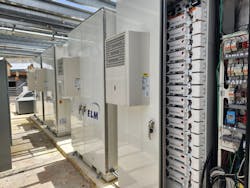Oak Ridge National Lab Microgrid Orchestrator to Create Grid of Microgrids in Puerto Rico
Oak Ridge National Laboratory (ORNL) is preparing to demonstrate a new microgrid orchestrator in Puerto Rico that will ensure the reliability of electrical service even if parts of the microgrid are damaged.
The new tool will establish a network of microgrids that can be managed as a single cluster – creating a grid of microgrids. For example, if one microgrid’s solar array is damaged in a storm, the orchestrator can direct another connected microgrid to export power to the affected area, mitigating the impact of the damage.
“I don’t know of a microgrid controller anywhere that can communicate and coordinate with another controller,” said Ben Ollis, an ORNL engineer working on the project. “We’re designing an architecture for multi-microgrid controls, so any number of microgrids can operate independently but share information to an orchestrator that will predict when switching, routing and connecting should happen.”
ORNL was awarded nearly $4 million from the U.S. Department of Energy Solar Technologies Office in 2020 to develop the tool, which will be deployed in Adjuntas, Puerto Rico.
The Adjuntas demonstration
Adjuntas, a remote mountain village in western Puerto Rico, was hit hard by Hurricane Maria in 2017, leaving the community without power for more than six months. In the wake of that storm, a group of small business owners determined that a microgrid was the solution that would ensure reliable power when the island’s power grid could not.
Adjuntas has two decentralized community-owned microgrids in its town square, thanks to local nonprofit Casa Pueblo, the Community Solar Energy Association of Adjuntas and the Honnold Foundation, which provided $1.7 million in funding.
The Honnold Foundation was established in 2012 by professional rock climber Alex Honnold, who is perhaps best known for making the first ascent of Yosemite’s El Capitan without ropes or other safety equipment (immortalized in the Oscar-winning documentary Free Solo). His foundation works to reduce global poverty by expanding equitable access to solar energy through community-scale solar projects.
The Adjuntas microgrid project is powered by nearly 700 solar photovoltaic panels sited on the roofs of 13 local businesses, as well as a 1.107-MWh battery energy storage system.
Designed to withstand hurricane force winds and support the community for up to 10 days in the aftermath of a major storm, the project was awarded the highest recognition prize at this year’s Microgrid Knowledge Greater Good Awards.
The ORNL-designed orchestrator, which is in the final stages of hardware testing, will allow the two microgrids to “talk” to each other, ensuring that the town’s residents have access to power and critical services in the wake of future natural disasters.
It is expected that the orchestrator will be deployed in Adjuntas within the next year.
Microgrids improve energy resilience in western Puerto Rico
About 12 miles west of Adjuntas, the mountain town of Castañer is also working to shore up its energy resilience. The community is collaborating with Texas A&M University on ways to better manage and withstand future natural disasters.
Like Adjuntas, Hurricane Maria left Castañer without power for six months.
“This community is highly susceptible to electric outages stemming from Puerto Rico’s fragile power infrastructure,” said Zheng O’Neill, associate professor of mechanical engineering at Texas A&M.
The resilience plan drawn up by O’Neill and his team includes the installation of solar panels, battery energy storage systems and two multiproperty microgrids.
“The proposed solution provides a communitywide low-cost sensing and control system that can coordinate different distributed generation controls and share information among stakeholders through the smartphone app to improve community resilience,” O’Neill said. “The technology can be scaled and replicated in many other similar rural, underserved communities with multiple solar panels and battery storage.”
The microgrid orchestrator could shape the future of the grid
Back in Adjuntas, the community and the project developers are excited about the benefits that will be provided by the microgrids – and especially the orchestrator.
“ORNL deploying this kind of controller system is going to be a really powerful tool for the community,” said Cynthia Arellano, project coordinator for the Honnold Foundation.
Once proven, the orchestrator technology could vastly improve electric reliability for grid edge communities around the world.
“The orchestrator includes a framework of algorithms that can be expanded and deployed to many microgrids at any site,” Ollis said. “I want to see a future where we have hundreds of microgrids working together to protect critical infrastructure at local, regional and national levels.”
Track news about microgrids. Subscribe to the free Microgrid Knowledge Newsletter.








